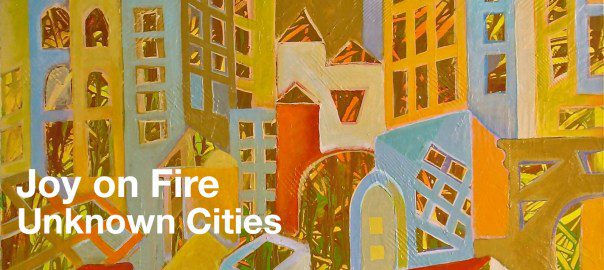“Why are you always writing battle music?” That’s how Joy on Fire bassist and principal songwriter John Paul Carillo said that their saxophonist Anna Meadors described their music when I interviewed the pair last year. In their latest release, Unknown Cities, the jazz-punk trio continues to flex their high-energy battle music muscles and virtuosic technique, while also continuing to show that they are equally adept at mixing things up.
We’ll actually begin with the final song on the album. One of my favorite things about Joy on Fire is their willingness to step away from their otherwise more characteristic sound. In the midst of their “battle music,” a song like “Rhopareptilia” from their Hymn album will come on and catch your ear for entirely different reasons. The album’s title track, “Unknown City,” is the latest example. There is a sort of active stasis to the song; while terms like “harmonic stasis” and “repetition” are apt descriptors, they belie the song’s bubbling energy and layered orchestration. “Unknown City” seems to recall 1960s minimalist music—I especially hear shades of Terry Riley’s “In C” in the pulsing notes that begin the piece. The association to minimalism is strengthened by the Moog-like synth bassline that runs throughout most of the song. Climaxes are achieved less through harmony and melodic peaks but through adding additional layers. It’s also worth noting that “Unknown City’s” minimalist influence delineates it from “In Speaking Like Thunder,” even though both songs contain lyrics by poet Dan Gutstein.
In many ways, the video for “Unknown City,” directed by both Meadors and Carillo and which is making its debut below here on 25YL’s Music Obsessive, complements the music very well. The combination of repetition, layers of images and fragments of images, harmonic stasis, and Gutstein’s lyrics (which heavily utilize repetition as well) create a hypnotic effect on the viewer/listener.
The first track on the album, “Kung Fu Tea Party,” immediately showcases the band’s strengths and versatility. Much like its title, the song is divided into two main sections, a pure “battle music” (the “Kung Fu”) section featuring menacing bass guitar and firey, sometimes siren-esque saxophone, and a much more melodic coda (the “Tea Party”). Meadors’ saxophone playing shines in the “Kung Fu” section: Carillo’s dark bass defines the song’s attitude, but Meador’s playing defines the song’s swagger.
When I interviewed the band, I asked them about what I called “sequel songs,” and there are (at least) two such songs on Unknown Cities: “CNC Pt. 2” and “The Complete Book Pt. 4” (the latter of which was hinted at during our conversation). “CNC Pt. 2” is the follow-up to the album’s previous track, “China, North Carolina,” while “The Complete Book Pt. 4” is the third installment in a series of songs that started with “The Complete Book of Bonsai” from their 2018 album of the same name (ironically, there isn’t currently a “Pt. 3”). One of the main connective threads between “Complete Book Pt. 1” and “Pt. 4,” and not one that I’m even sure was intentional, is the nearly song-length build towards the climaxes that the two songs share, steadily adding layers and volume until the wave finally breaks.
Because “China” and “CNC” flow seamlessly into one another, using similar basslines as their connecting thread, it isn’t a stretch to say that their combined 18-minute runtime makes the two songs the de facto heart of the album. “China” begins with an extended solo from Meadors bolstered by looping and other electronic effects; after some time, the solo’s more contemplative nature gives way to an infectiously grooving bassline. Drummer Chris Olsen really gets to shine in “CNC,” even before his extended solo closes the song.

The opening of the fifth track on the album, “In Speaking Like Thunder (Red Wave Slow Mix)” strikes me as slightly more anthemic with its soaring electric guitar. It is also the first of two tracks on the album with lyrics and vocals by Gutstein (maybe the typically instrumental band chose to take the phrase “In Speaking” literally!). One of my favorite moments on the album occurs about two-thirds of the way through the song when there is an interplay between Gutstein’s vocals and Meadors’ layered saxophones. During this section, Meadors mimics the cadence of Gutstein’s lyrics (or maybe, in keeping with the theme of speaking like thunder, it is the other way around?). Even though it’s brief, it’s a very cool effect. This section kicks off the song’s climax, where structure and form seem to disintegrate into a thunderous wave of sound complete with timpani drums.
“In Speaking” moves fairly smoothly into the following song, “Red Wave.” I’m not sure if “Red Wave” qualifies as a sequel song, although the words are in the full title of “In Speaking” and the chord progression is very similar. True to their name, I think that “Red Wave” is the most joyful track on the album. The first half of the song seems to be in a verse-chorus form—a standard pop music form that I don’t typically associate with Joy on Fire’s more rhapsodic style—before loosening up for soloing. I especially like the chorus, which occurs roughly 1:20 into the song, which adds clapping effects to Carillo’s driving bass, Meadors’ thrilling saxophone “vocals,” and Olsen’s crashing cymbals.
Overall, Unknown Cities is another strong and exciting entry in Joy on Fire’s catalog. The band’s virtuosity—both in their playing and songwriting—and chemistry are on full display throughout.

